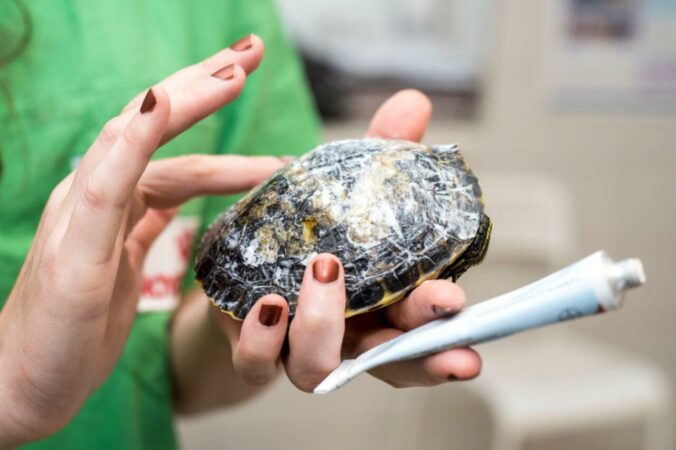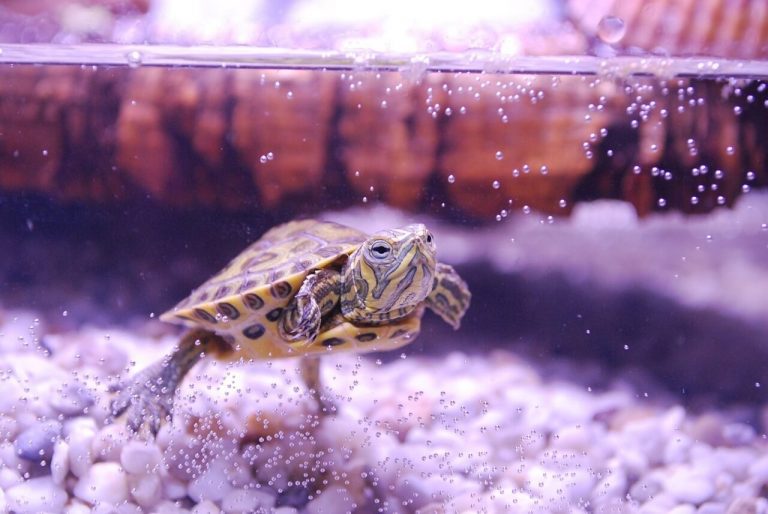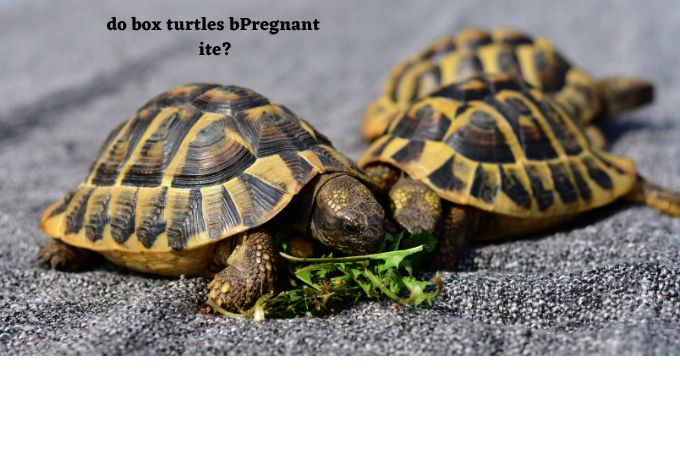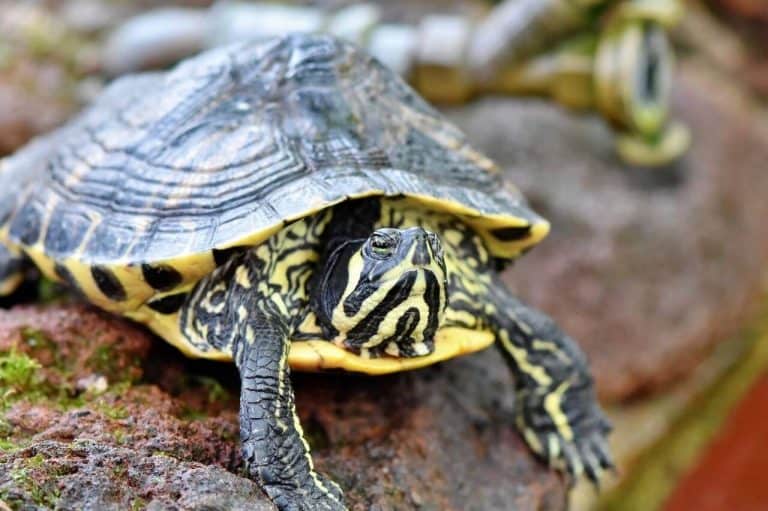Turtle Shell Rot | Symptoms, Causes & How to Treat Shell Rot in Turtles
Turtle shell rot is a painful infection that affects the turtle’s shell. This concerns many turtle owners who want more information on the topic. Unfortunately, most turtle care guides do not address this issue, making it difficult for owners to handle the infection. To help with this, we have created a detailed guide on the causes, symptoms, and treatment of shell rot disease in turtles. Let’s continue our discussion.
[amazon box=”0764141910″ grid=”1″ price=”none”]
What Is Turtle Shell Rot?
Before we delve into the discussion, let’s first establish a clear understanding of what shell rot disease means for turtles.
It is a serious infection that gradually deteriorates the turtle’s carapace and plastron. This disease spreads rapidly when external bacteria damage the turtle’s blood vessels.
Typically, shell rot symptoms manifest on both the upper and lower halves of the carapace. Various factors can contribute significantly to its development, such as shell damage or inadequate access to clean drinking water. Additionally, the healing process for a turtle afflicted with shell rot can be time-consuming.
However, by following our guidelines, the turtle should experience a swift and comfortable recovery.
Causes of Shell Rot in Turtle
Several reasons can lead to infectious shell rot in your pet turtle, with the leading cause being shell damage. The three common causes of shell rot are:
1. Shell Damage
Shell rot is primarily caused by shell damage. When the shell is broken or damaged, it provides an entry point for external bacteria to infect the exposed blood vessels, leading to harmful infections. The most common causes of shell damage are as follows:
- Fighting: Territorial turtles will fight for their space in the enclosure. It will often injure the turtles and crack their carapace. It happens when the turtle pond or aquarium becomes overcrowded.
- Inappropriate weather: The turtle shell is sensitive to subtle changes in temperature and humidity. If the humidity and temperature inside the turtle enclosure are problematic for a longer period, it will damage the shell.
- Piercing: If you accidentally put sharp metal or galls inside the turtle cage, it might hurt the carapace. Also, the sharp edges around the cage and the basking spot can damage the shell badly.
2. Inappropriate Habitat
Dirty tank or pond water can lead to mold growth, which can quickly infect a damaged turtle shell with bacteria. A wet and moldy enclosure provides an ideal breeding ground for harmful bacteria, which can affect the exposed blood vessels.
This situation is exacerbated by the fact that turtles are messy animals, and they can easily turn their habitat into a dirty place filled with food waste.
3. Lack of Dry Place
Turtles need a dry spot near their water source to rest and dry off. Even though they spend most of their time swimming, these spots are important for them to dry when needed.
If a turtle stays in its shell all day, it can lead to shell rot due to increased mold and bacterial growth. Therefore, it is important to provide a suitable basking spot. One option is to install a floating reptile dock in the aquarium.
Symptoms of Turtle Shell Rot
You may observe several symptoms in your pet turtle when it becomes sick due to shell infection due to a bacterial attack. Some common symptoms include the following ones.
- Usually, while inspecting the turtle shell, you might find cracks in it. As the day passes by, the cracks will have a white appearance with moth-eaten signs.
- The shell won’t look even as it was earlier. The carapace plates (not all) might come out of the edge and give a mazy look to the pet turtle.
- At worst, blood and other discharges will come through these cracks. The discharge will have a bad smell that will quickly grab your nostrils’ attention.
- Lastly, parts of the shell might start coming out and expose the bones underneath. It is a DEATH SIGN.
Treatment of Shell Rot Disease
You should make a turtle health checklist and examine the turtle weekly. Whenever you see any damage or cracks on the shell, you must start the healing process ASAP.
Identifying The Reason For Shell Rot
To address shell rot symptoms in a turtle, first determine the underlying cause. Is it due to overcrowding or unsanitary water conditions in the turtle’s habitat?
Once you have identified the cause, take appropriate action to resolve it. For example, if fighting is the issue, separate the turtles into individual tanks.
Isolating The Turtles
Next, isolate the infected turtle in a dry place to aid in the healing of its cracked shell. This is important as a wet shell can accelerate the growth of bacterial colonies compared to a dry carapace.
Continuous Cleaning of The Shell
To remove the bacteria from the carapace quickly, clean the damaged shell. Start by finding a soft-bristled toothbrush, preferably a baby toothbrush.
Use it to remove dirt and debris from the shell. Next, gently scrub the turtle and dry it with a clean towel. Regularly repeat this cleaning process until the shell damage begins to heal.
Killing The Bacteria
To kill bacteria on the turtle shell, bathing and cleaning alone are not enough. You need to use an antibacterial medicine.
We suggest using Chlorohexidine solution or hydrogen peroxide, although the latter works slower. Apply the antibacterial solution to the cracked shell of the tortoise once daily until it heals.
Use of Healing Cream
While there are many healing creams available, it is important to choose the best one for your pet turtle. We suggest using silver sulfadiazine antibiotic cream for the quickest treatment of shell rot. Neosporin is also an option.
red eared slider shell rot treatment:
Red eared slider shell rot treatment usually includes antibiotics to eliminate the infection and rehabilitating the turtle’s shell with a calcium supplement.
Others have found success with natural remedies, like feeding the turtle a vegetable-rich, low-protein diet and maintaining a clean and humid environment.
healthy red eared slider shell:
The best way to keep the healthy red eared slider shell is by providing a healthy diet and plenty of water. Make sure to feed your turtle a balanced diet of fresh vegetables and fruits, as well as meaty proteins. And be sure to give your turtle plenty of clean water to swim in.
Conclusion
Untreated turtle shell rot can be fatal. It begins with a cracked or damaged shell and worsens due to bacterial infection. Fortunately, this disease can mostly be treated at home. The treatment and healing process for shell rot generally lasts around five to seven days.
Throughout this period, keep the turtle isolated and ensure it stays dry. When transferring the treated turtle back into its tank, make sure the tank is clean and has suitable water conditions.





